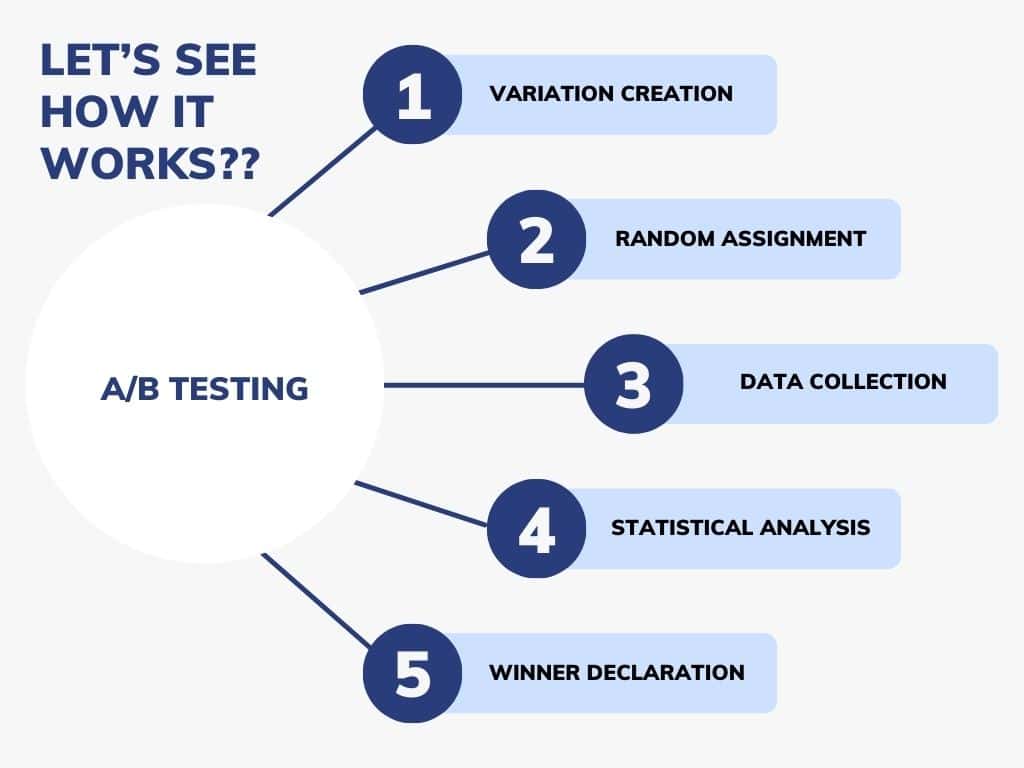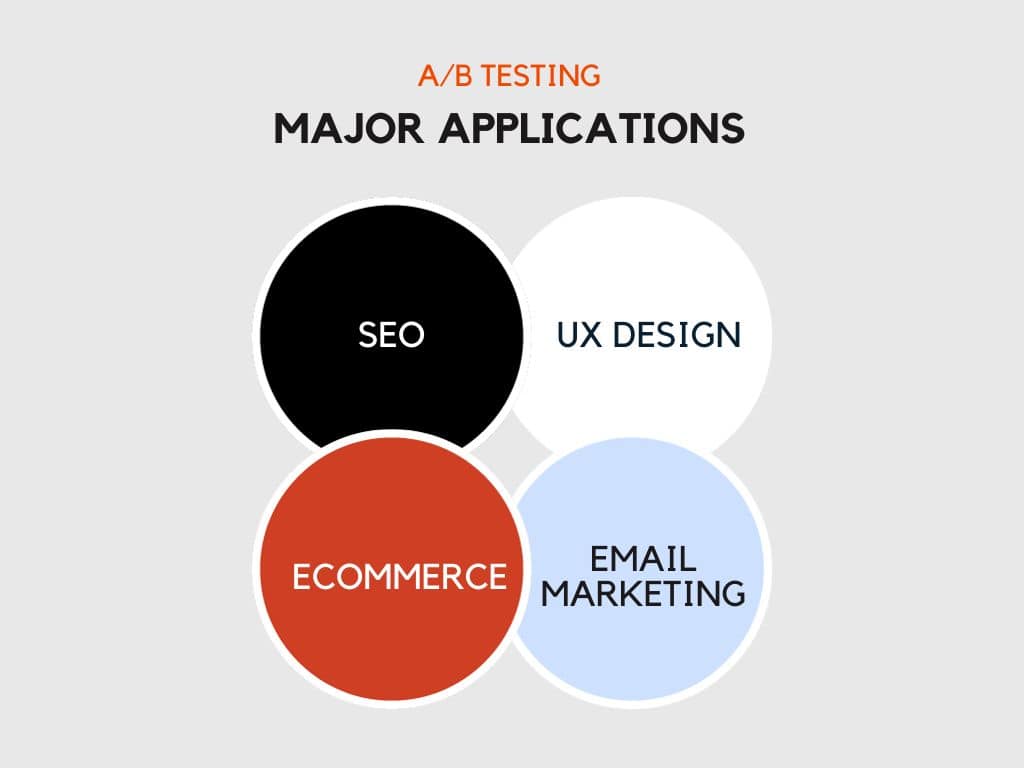
Long back, marketers and web designers trusted their intuition to design a website or produce a marketing copy that would generate clicks and conversions. But now in this fast-paced world and age of big data, such intuition is not good enough and what matters is website analytics and statistical data.
Thus, making informed decisions using reliable data will help you with achieving your goals. A/B testing is one powerful tool that helps businesses make informed decisions and data-driven choices.
In this blog, we can try to understand A/B testing, explore its significance, applications, and tools along with some insights into how it can transform your business.
What Is A/B Testing?
In A/B testing, we can compare two or more versions of a webpage, email, mobile app, or other marketing campaigns to determine which one performs better with your target audience. With this, you can understand what will help you achieve your goals ranging from increasing click-through rates, improving conversion rates, or reducing bounce rates.

Here’s how it typically works:
- Variation Creation: You create two or more versions (A and B) of the element you want to test. These variations differ by a single element, which could be anything from a headline, image, button color, or call-to-action text.
- Random Assignment: Users are randomly assigned to see one of the variations. This ensures that the test results are not biased by user characteristics.
- Data Collection: As users interact with the different variations, their actions are tracked, and data is collected. This data can include clicks, conversions, engagement metrics, and more.
- Statistical Analysis: The collected data is then subjected to statistical analysis to determine if there’s a significant difference in performance between the variations. Statistical significance ensures that the observed differences are not due to chance.
- Winner Declaration: Once statistical significance is established, you can declare a winner, the variation that performs better according to your predefined goal.
Why A/B Testing Matters
You must already know why it matters! But let’s take a look at some hard facts that will help you realize how important A/B testing is for today and the future.
- Data-Driven Decision Making: One of the most significant advantages of A/B testing is that it replaces guesswork with hard data. Instead of relying on assumptions or intuition, you make decisions based on real user behavior. This results in more accurate and effective strategies.
- Continuous Improvement: A/B testing fosters a culture of continuous improvement. It allows you to fine-tune your website, emails, and marketing materials iteratively. Small, incremental changes can lead to significant improvements over time.
- Maximizing Conversions: For businesses, the ultimate goal is often to drive conversions, whether that’s making a sale, generating leads, or getting users to take a specific action. It helps to optimize your assets for maximum conversion rates.
- User-Centered Design: A/B testing is all about understanding your users’ preferences and behaviors. By catering to their preferences, you create a user-centered design that enhances user satisfaction and loyalty.
- Cost Efficiency: In traditional marketing, significant investments are made in campaigns without knowing if they will yield results. It minimizes this risk by ensuring that your strategies are backed by evidence, thus making marketing spending more efficient.
Key Elements for Successful A/B Testing
To harness the power of A/B testing effectively, keep these key elements in mind:
- Clear Goals: Define what you want to achieve with your A/B test. Is it higher click-through rates, increased sign-ups, or more sales? Specific goals guide your testing strategy.
- Isolated Variables: Change one element at a time to isolate the impact. If you alter multiple things simultaneously, it becomes challenging to attribute changes to a specific element.
- Sufficient Sample Size: Ensure that you collect data from a large enough sample size to achieve statistical significance. Small sample sizes can lead to unreliable results.
- Patience: A/B testing requires patience. You may need to run tests for an extended period to collect enough data for reliable results.
- Iterative Approach: Don’t stop testing once you’ve found a winning variation. Continue testing and optimizing to achieve even better results.
Major Applications of A/B Testing
A/B testing helps you optimize various aspects of your online presence through a trial-and-error method in the quickest way available.

From improving SEO and UX design to boosting e-commerce sales, enhancing marketing emails, and refining mobile apps, the benefits of A/B testing are many if implied correctly.
1. A/B Testing for Better SEO
A/B testing is an effective way to increase the website’s search engine ranking. But it can also pose a risk if not used correctly.
Google suggests some A/B testing best practices to help use it in the right way. Let’s have a look at it;
- Avoid Cloaking: Simply put, cloaking is the practice when a website shows different content to the search engine than what it would normally show. This will of course confuse the search engine and will result in your site being demoted or even being removed from the search results.
- Use Canonical Tags: Canonical tags are HTML tags that tell search engines which version of a page is the master version. This helps to prevent duplicate content issues, which can be detrimental to SEO.
- Test One Element at a Time: To isolate the impact of the changes you make, test one on-page element at a time.
- Document Your Tests: Maintain well-documented records of your A/B tests. This should be referred to before making any new changes or conducting another test.
2. A/B Testing in UX Design
UX design decisions should be made by taking into real user data. A/B testing is the best way to base your product design while allowing your users to participate in the decision-making.
Learn how small changes will influence user behavior, decide which design approach to implement, and make sure the new design changes are giving the right results. This will happen over time, but the improvement in UX is guaranteed.
As you know, good UX will give you loyal customers and bad UX has the exact opposite impact. Run A/B test, conduct UX research, and find out what works and what doesn’t work. In the end, make sure you have a good UX.
3. A/B Testing for eCommerce
A/B testing for eCommerce will help you achieve conversion optimization of your website. But, you must consistently keep doing it, that is, to hypothesize, test, experiment, and repeat.
It can be used in an eCommerce site to fix common online shopping hassles. These include shipping costs, Call-to-action, using compelling images on product pages, headline wording, typography, personalization, and of course the right kind of notifications.
Many other elements can also be tested and learned from. Be creative with the elements you want to test on your eCommerce website and build the version of it!
4. A/B Testing in Email Marketing
A/B testing your emails is important to improve your email marketing campaign. Ask yourself what will be the impact of each small change you make during the A/B test. Go with the ones that gave you the best and most positive results.
For this create a clear idea for the improvement you want to make in your campaign. Set it up as an A/B test, click send, and see what happens. It will help you learn more about your client preferences and help you set up the best email campaigns.
For email campaigns, you can use tools like Campaign Monitor or Sendgrid, which allows you to carry out A/B tests and gives you real user data.
Start A/B Testing Now!
Always make informed decisions, improve user experience, and maximize conversions with A/B testing!
It will start showing results when used deliberately and consistently. Take time to understand what your audience needs and deliver accordingly.
